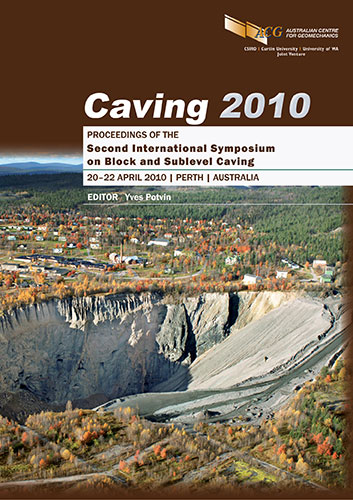Initial and east cave breakthrough events at Palabora Mining Company

|
Authors: Glazer, SN; Townsend, PA |
DOI https://doi.org/10.36487/ACG_rep/1002_4_Glazer
Cite As:
Glazer, SN & Townsend, PA 2010, 'Initial and east cave breakthrough events at Palabora Mining Company', in Y Potvin (ed.), Caving 2010: Proceedings of the Second International Symposium on Block and Sublevel Caving, Australian Centre for Geomechanics, Perth, pp. 107-118, https://doi.org/10.36487/ACG_rep/1002_4_Glazer
Abstract:
Understanding cave induced seismicity is important to better understanding the processes of block cave mining. This seismicity is a natural process indicating that the cave is progressing and is connected with rock mass fracturing ahead of the undercut and propagating cave. The space and time distribution of seismicity, as well as changes in their source parameters over time, are directly associated with what is happening in the rock mass around the cave and underground mining infrastructure. The initial cave breakthrough into the overlying open pit took place in May 2004 while the east breakthrough took place during the months of May and June 2008. There is a great deal of similarity as regards stress changes (as indicated by the energy index time histories), migration of seismicity, seismic energy release as well as seismic deformation patterns, with respect to the two breakthrough events. There are also some differences but they are easy to explain as the initial breakthrough took place 25 months after the stress caving process was initiated while in case of the east breakthrough, this time span had increased by a further four years. The continuous caving process during these four additional years had to significantly change the conditions of the rock mass around the cave that resulted in these differences. The energy index time histories for the two breakthrough events are very similar, indicating a stress increase prior to the breakthrough with a rapid stress release post-breakthrough. The main differences relate to the stress levels. Based on the energy index time histories the stress levels prior to the initial breakthrough were higher than those prior to the east breakthrough. The rapid stress release period in both cases was about six times shorter than the period during which the stresses were high. In both cases the pillar failure, and thereafter the breakthrough, resulted in major changes in the stress patterns around the mine. After the failure of the crown pillar larger size seismic energy releases started to appear below the extraction level. When the east pillar failed and broke through there were also some larger seismic energy releases taking place below the extraction level. In both cases the two breakthrough events resulted in an increase in the seismic hazard. The analysis presented shows that not only can seismic data analysis be successfully used to monitor the caving process, but also confirms the reliability of the process.
References:
Brummer, R.K., Li, H. and Moss, A. (2006) The transition from open pit to underground mining: An unusual slope failure at Palabora, The South African Institute of Mining and Metallurgy, International Symposium on Stability of Rock Slopes in Open Pit Mining and Civil Engineering, April, pp. 411–420.
Glazer, S.N. and Hepworth, N. (2004) Seismic Monitoring of Block Cave Crown Pillar – Palabora Mining Company, RSA, in Proceedings MassMin 2004, K. Karzulowicz and M.A. Alfaro (eds), Mineral Chilena, Santiago, Chile, pp. 565–569.
Glazer, S.N. and Hepworth, N. (2005) Seismicity Induced by Cave Mining, Palabora Experience, in Proceedings Sixth International Symposium on Rockbursts and Seismicity in Mines, Y. Potvin, and M. Hudyma (eds), Australian Centre for Geomechanics, pp. 281–289.
Glazer, S.N. and Hepworth, N. (2006) Crown Pillar Failure Mechanism – Case Study Based on Seismic Data from Palabora, in Mining Technology 2006, Institute of Minerals and Mining, Published by Maney, Vol. 115, No. 2, pp. 75–84.
Glazer, S.N. (2007) Applications of mine Seismology Methods in Block Cave Mining, in Proceedings 1st International Symposium on Block and Sub-level Caving, Cape Town, October 2007, Symposium Series S49, SAIMM,
pp. 281–301.
Glazer, S.N. (2008) Seismically Active Volume Around the Cave and its Relation to the Caving Stages, in Proceedings 5th International Conference and Exhibition on Mass Mining, H. Schunnesson and E. Nordlung (eds), Luleå, Sweden, 9–11 June 2008, pp. 983–992.
Glazer, S.N. and Townsend, P. (2008) The Application of Seismic Monitoring to the Future Lift 2 Development at Palabora Mining Company, in Proceedings 5th International Conference and Exhibition on Mass Mining,
H. Schunnesson and E. Nordlung (eds), Luleå, Sweden, 9–11 June 2008, pp. 919–930.
Sainsbury, B., Pierce, M.E. and Mas Ivars, D. (2008) Analysis of caving Behaviour Using a Synthetic Rock Mass – Ubiquitous Joint Rock Mass Modelling Technique, in Proceedings 1st Southern Hemisphere International Rock Mechanics Symposium, SHIRMS08, Y. Potvin, J. Carter, A. Dyskin, and R. Jeffrey (eds), Australian Centre for Geomechanics, Vol. 1: Mining and Civil, pp. 243–253.
© Copyright 2025, Australian Centre for Geomechanics (ACG), The University of Western Australia. All rights reserved.
View copyright/legal information
Please direct any queries or error reports to repository-acg@uwa.edu.au
View copyright/legal information
Please direct any queries or error reports to repository-acg@uwa.edu.au